This article was originally published in the January/February 2022 Issue of the WatchTime print magazine. Photos by IWC and Olaf Köster.
IWC has been developing and building watches for pilots for 85 years. Originally inspired by cockpit instruments, these wristwatches are still regarded today as robust, precise, functional and reliable. And they have long since ceased to be solely for professional pilots. Rather, its unmistakable appearance makes an IWC Pilot’s Watch a trendy “tool watch,” i.e., a genuinely practical tool, which you can use to master many situations in everyday life.
In 1936, IWC introduced its first Pilot’s Watch. It had a rotating bezel with a tapered hand for marking a departure time. This Pilot’s Watch encased hand-wound Caliber 83, which was equipped with an antimagnetic escapement.
In the late 1930s, IWC developed a professional watch for pilots for the German Air Force with a satin-finished steel case and a diameter of 55 mm. Other features included an easy-grip winding crown, a black dial with luminescent numerals and hands, a stop-seconds function and a long leather strap so the watch could be worn over a flight suit. Each timepiece also had to meet the test conditions of the German naval observatory, which measured the timekeeping in six positions and at three different temperatures. Powered by hand-wound Caliber 52 T.S.C., this timepiece, as well as identical models made by the German watch manufacturers A. Lange & Söhne, Laco, Stowa and Wempe, played a decisive role in shaping the design of the genre of the pilots’ watch.
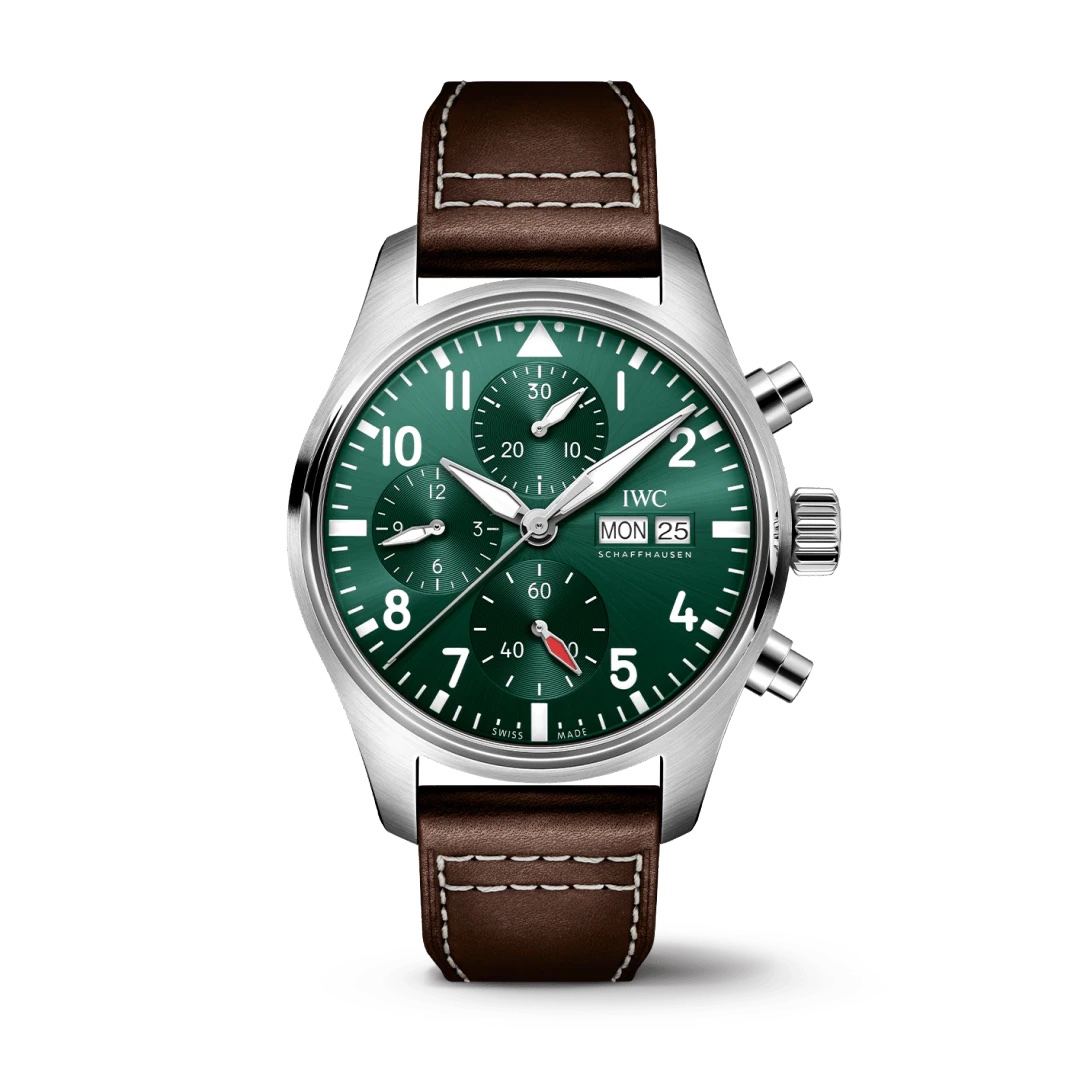
The Mark 11 debuted in 1948 and soon became a real cult watch. Many aircraft captains relied on this timekeeper, which had a softiron inner case, which protected Caliber 89 against magnetic fields up to an intensity of 80,000 amps per meter. Many subsequent generations of the “Mark” were patterned after this model.
IWC continued its tradition of pilots’ watches in 1988 with a Pilot’s Chronograph based on the ETA/Valjoux’s Caliber 7750, a mass produced, automatic movement that has already proven its mettle in millions of watches. Modified and assembled by the experts in Schaffhausen, this caliber ticked for many years inside IWC Pilot’s Chronographs, including various special editions and models with split-seconds complications. But newly designed manufacture calibers in the 69000 series are now gradually replacing chronograph movements based on the ETA/Valjoux 7750.

New 69000 Caliber Family Replaces the ETA/Valjoux 7750
The 69000 caliber family was developed over a period of four years and made its debut with Caliber 69375 inside the Chronograph Ingenieur in 2017. Caliber 69380 arrived two years later in the Pilot’s Watch Chronograph Spitfire. Now, after another two years, Caliber 69385 powers the Pilot’s Watch Chronograph 41, which belongs to the Standard Collection and was given this name because there are other unusual models, such as the Pilot’s Watch Chronograph Edition “Antoine de Saint- Exupéry” or the Pilot’s Watch Chronograph Top Gun Ceratanium, that encase Calibers 79320 and 79420. These numbers refer to the corresponding ETA/Valjoux 7750 basic caliber. You can tell the difference immediately with a quick glance at the dial. The ETA/Valjoux 7750-based calibers have their subdial for the seconds at the 9 and the chronograph’s counter for up to 12 elapsed hours at the 6, while the positions of these two indicators are reversed on the dials of watches that encase the calibers in the 69000 series.
A Chronograph Movement Designed To be Robust and Suitable for Everyday Use
On the Pilot’s Watch Chronograph 41 with green dial, our test watch, the progress of the seconds is shown with a small red hand on a subdial at 6 o’clock. The red color makes it easy to distinguish this seconds hand from the chronograph’s elapsed-time hands. When the chronograph is switched on, the elapsing seconds are shown with a slender steel needle at the center of the dial, while the elapsing minutes are tallied on a subdial at 12 o’clock. The small white hand for the elapsed minutes advances position farther along each time the elapsedseconds hand passes its zero position, i.e., every 60 seconds. As stated earlier, the elapsed hours are counted on a subdial 9 o’clock, where an identical small white hand advances slowly and continuously. This hand’s gradual progress indicates that it is powered by the same basic construction in Caliber 69000 as in ETA/Valjoux’s Caliber 7750. But there are a few differences. After all, the automatic column-wheel chronograph movement is a modern, newly designed caliber.
Manufacture Caliber 69385 inside the Pilot’s Watch Chronograph 41 consists of 231 individual components and, like every IWC Pilot’s Watch, was designed with a focus on robustness, reliability and precision. This is also why the chronograph, which can be used to tally intervals of up to 12 hours’ duration, is controlled by a column wheel. This complex component with two functional levels remains a challenge to manufacture, although modern design and production methods make the processes involved in its fabrication easier today.
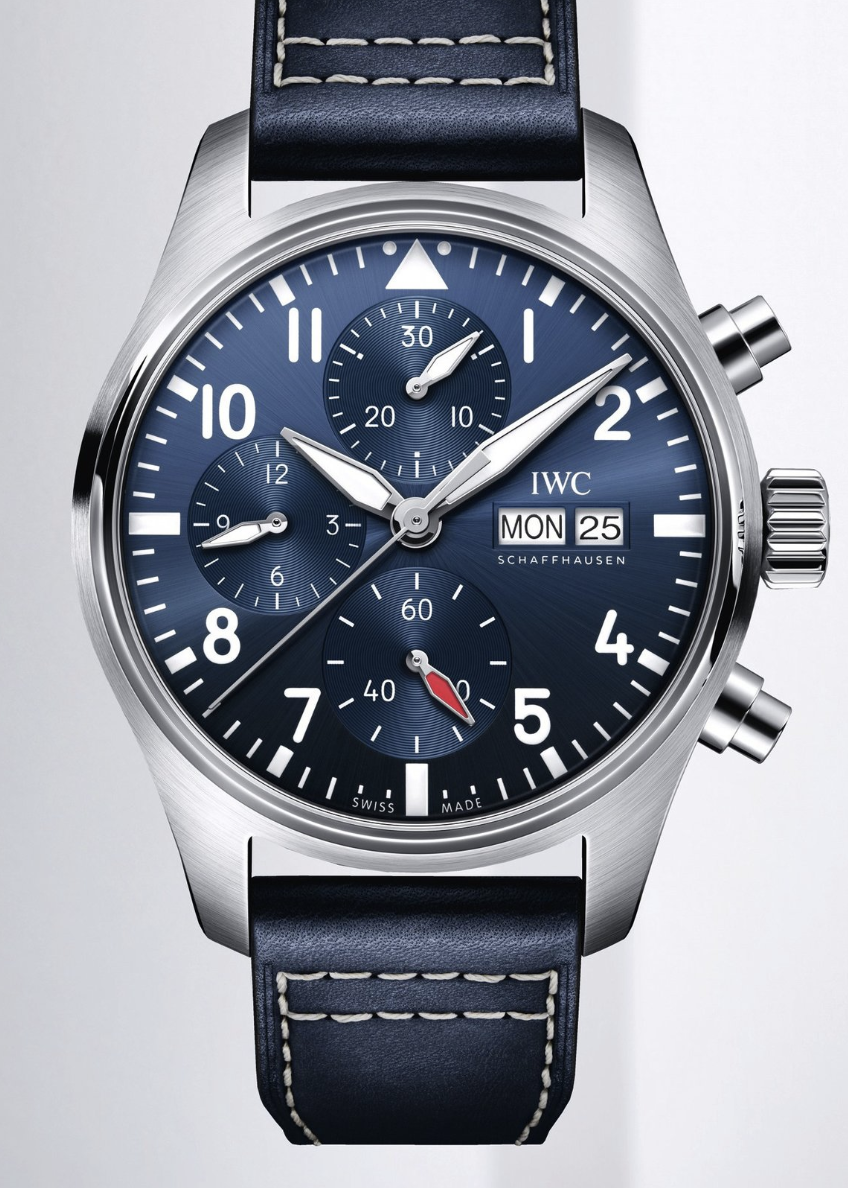
A traditional rocking pinion alternately couples and uncouples the going-train from the chronograph. The energy, on the other hand, is provided by a modern, double-acting, self-winding system with a pawl. But this is not the winding system that’s named after IWC’s former engineer Albert Pellaton, which is still used in the calibers of the 89000 series. Rather, the bidirectional click winding system installed here results from a recent development within the Richemont Group. This innovative system efficiently converts kinetic energy from the motions of the wearer’s wrist into tension for the mainspring, which provides a 46-hour power reserve when fully wound. This is not an unusually long running autonomy by today’s standards as contemporary chronograph calibers often offer greater power reserves. For example, the ETA/ Valjoux movement, modernized to Caliber A05, offers 60 hours, as does the updated El Primero 3600 or Caliber 9900 in Omega’s Master Chronometer. Breitling’s Caliber B01 offers 70 hours and Heuer’ Calibre 02 provides 80 hours of power autonomy.
The frequency of the balance can be finely adjusted by shifting the position of the regulator. This is a simpler method than turning eccentric screws along the balance’s rim as is done in Caliber 89000, but IWC opted for the less complex variation because the company wanted to add a less expensive caliber to this series. Several thousand dollars separate the prices of models encasing different calibers.
Caliber 69385 keeps time quite respectably. Our wearing test measured an average daily gain of 3.5 seconds. We were pleased to see that neither the rate behavior nor the amplitudes deviated significantly when the chronograph was running. With the stopwatch function activated, the average daily gain was 1.8 seconds and the amplitudes hovered around 285 degrees.

The New Chronograph Maintains IWC’s Pilot’s Watch Heritage
A gaze through the window of sapphire crystal in the screw-in back of the case, which now resists pressures up to 10 bar (compared to the former pressure resistance of 6 bar), shows the typical features and finishings of IWC’s calibers, for example, circular graining, circular grinding in Geneva-wave style, and satin finishing on the skeletonized rotor with the well-known engraving: “Probus Scafusia.”
This promise of quality, which was used as early as 1903 and means “Proven from Schaffhausen,” is also implemented in the Pilot’s Watch Chronograph 41, this new addition to IWC’s popular portfolio of established Pilot’s Watches. No matter how you look at this chronograph, it reflects the typical DNA of an IWC Pilot’s Watch. The stainless-steel case, measuring 40.85 mm in diameter and 14.55 mm in height, is mostly satin finished. Only the steep and narrow bezel has a bit of high gloss shine and is the sole exception to the norm that IWC Pilot’s Watches have upheld since the 1930s.

The round chronograph pushers, which run through bushings, and the large threaded crown are unmistakable. Thanks to the crown’s deep knurling, it is easy to to unscrew. The crown slides into its withdrawn positions with secure latching points; a bit of pressure returns it safely to its inserted position. When the crown has been withdrawn to its middle position, the date and the day of the week can be smoothly reset by turning the crown clockwise or counterclockwise. When the watch is running, the calendar indications “creep” toward their next settings between 11:25 p.m. and 12:10 a.m. The day of the week changes first, followed by the date. Both the switching operations and the positioning of the calendar display at the 3 recall the past, when the ETA/Valjoux caliber was used.
A Perfect Pilot, Even with A Green Dial
Thanks to column-wheel control, the buttons for the chronograph function have secure pressure points and move surprisingly evenly. Triggering the stopwatch function starts the slender elapsedseconds hand, which sweeps smoothly along the bold scale on the edge of the dial. However, while the indexes and Arabic numerals are eye-catching and amply dimensioned, only the three larger markers at the 3, 6 and 9 are luminous, as are the orientation triangle and its two dots at the 12 as well as the lance-like, rhodium-plated hour and minute hands for the main time display from the dial’s center. This matches the typical luminous arrangement on IWC’s other Pilot’s Watches, although the numerous white markers here might lead to the mistaken conclusion that all 12 hour markers glow in the dark.

In daylight, all 12 markers contrast excellently with the currently popular glossy green sunburst dial, which explains why the dial is very easy to read on the whole. Depending on how the light falls, the color of the dial varies from a luminous green to almost black and sometimes only the circular-grained counters appear black, thus creating a contrast with the otherwise green background. The excellent readability that always distinguishes IWC’s Pilot’s Watches is further improved by the slightly domed sapphire crystal, which sometimes gives the impression that it is not there, thanks to antireflective coating on both its upper and its lower surface.
The EasX-Change system is new, but has already proven its merits. This innovative solution eliminates the task of fiddling with the wristband’s crosspieces or even taking a trip to the jeweler when you want to change one wristband with another. Applying slight downward pressure on the metal clamps at the reinforced ends of the strap releases the clamps from the crosspieces and makes it easy to remove the two halves of the strap. An audible “click” signals the successful insertion of a new wristband, and that’s all there is to it. Options include calfskin and rubber straps in various colors, as well as a new, slender, stainless-steel bracelet with an integrated system to finely adjust its length. Attached to the familiar brown calfskin strap that tapers slightly about two centimeters beyond the strap lugs and has contrasting colored stitching and an angular pin buckle, the Pilot’s Watch Chronograph 41 with its green dial proves to be a perfect IWC Pilot’s Watch.
IWC Pilot’s Watch Chronograph 41 Specs:
Manufacturer: IWC Schaffhausen, Baumgartenstrasse 15, 8201 Schaffhausen, Switzerland
Reference number: IW388103
Functions: Hours, minutes, seconds subdial, weekday, date, chronograph (central elapsedseconds hand, counters for up to 60 elapsed minutes and 12 elapsed hours)
Movement: IWC 69385 based on Caliber family 69000, automatic, 28,800 vph, 33 jewels, Incabloc shock absorption, fine adjustment via bipartite regulator, Glucydur balance, 46-hour power reserve, diameter = 30.0 mm, height = 7.90 mm
Case: Stainless steel with domed sapphire crystal above the dial with anti-reflective coating on both sides and secured against sudden loss of pressure, sapphire crystal in the caseback, water resistant to 100 m
Strap and clasp: Brown calfskin strap with pin buckle
Rate results: Deviation in seconds per 24 hours (Fully wound / after 24 hours)
Dimensions: Diameter = 40.85 mm, height = 14.55 mm, weight = 110.0 g
Variations: With blue dial and calfskin strap (Ref. IW388101, $6,500); with blue dial and stainless-steel bracelet (Ref. IW388102, $7,200); with green dial and stainlesssteel bracelet (IW388104, $7,200)
Scores:
Strap and clasp (max. 10 points): Rustic, high quality, leather strap matches the Pilot’s Watch style, practical system for changing wristbands, various strap options. 9
Case (10): A simple, classic case in IWC’s familiar Pilot’s Watch style, anti-reflective crystals, screw-down crown. 8
Dial and hands (10): Dial in trendy green; the DNA of IWC’s Pilot’s Watches has been preserved in the bold numerals, hands and indexes. 9
Design (15): The watch’s entire design follows IWC’s characteristic Pilot’s Watch style. 14
Legibility (5): Easy to read thanks to the large typeface, strong contrasts and anti-reflective crystal, nighttime luminosity follows the IWC Pilot’s Watch DNA. 5
Operation (5): Easy to use screw-down crown, the pressure points of the push-pieces are very uniform, perfect strap changing system.
To learn more about IWC, click here, and to subscribe to the WatchTime print magazine, click here.


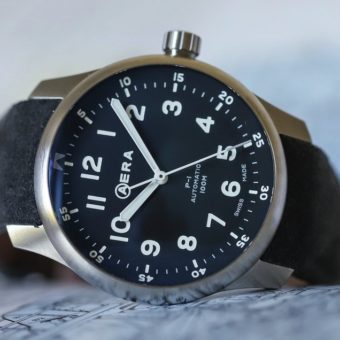

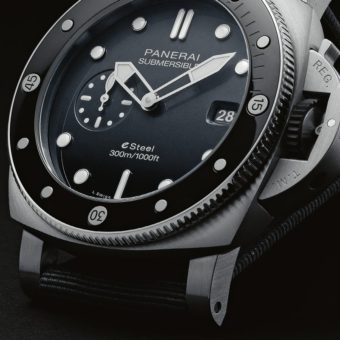

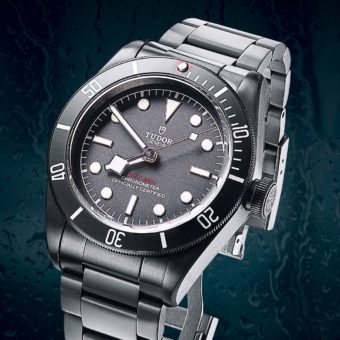
And what is the price???